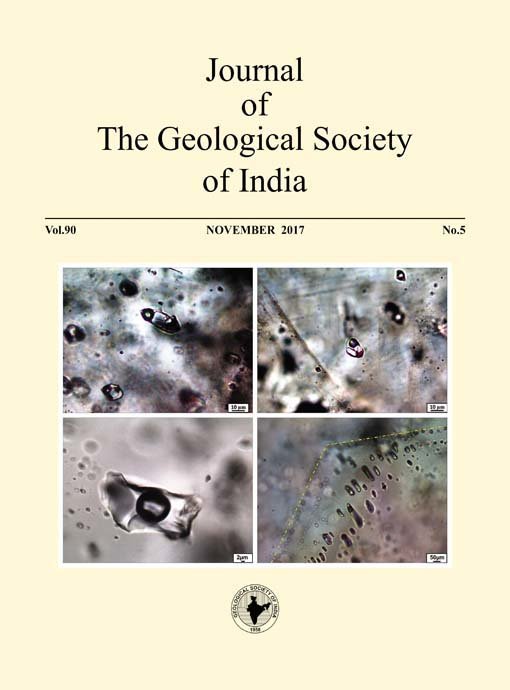Remote Sensing Technique for Capturing and Exploration of Mineral Deposit Sites in Gumushane Metallogenic Province, NE Turkey
DOI:
https://doi.org/10.1007/s12594-017-0762-0Abstract
This study examines the determination and confirmation of mineral deposits in the Gumushane Province, Turkey. Rather than using classical techniques, Remote Sensing (RS) and Geographic Information System GIS technologies are applied for this purpose. Mineral alteration traces on the ground are characteristic indicators of ore below the surface. These traces can be determined using RS techniques. The Crosta technique is one of the most important RS image analysis methods used for the determination of mineral alterations. The technique has shown particular usefulness around mine areas, which are rich in ore deposits and show hydrothermal alterations. Therefore, four separate mine fields covering a total area of 718 km2 in the southern part of Gumushane, which is rich in iron oxides, hydroxides and hydrothermal alteration, were chosen. The Crosta technique was applied to the satellite image of each area to explore the regional alterations. The determined locations could be confirmed as alteration areas. Within these four regions, some other locations showing similar alteration patterns were also determined using the Crosta technique. These locations represent good candidates for mineral exploration.Downloads
Metrics
Issue
Section
Downloads
Published
How to Cite
References
Abrams, M., Brown, D., Lepley, L., Sadowski, R. (1983) Remote sensing for porphyry copper deposits in Southern Arizona. Econ. Geol., v.78, pp.591– 604.
Aydal, D., Arda, E., Dumanlilar, í–. (2007a) Applications of Crosta Tecniques on alteration mapping of the granitoidic rocks using Landsat ETM+ 7: A case study in eastern taurite belt, SE Turkey. Internat. Jour. Remote Sensing, v.28, pp.3895–3913.
Aydal, D., Vural, A., Polat, O. (2004) Definition of the Base Metal and Gold Bearing Hydrotermally Altered Areas in Volcanic Rocks Using By Landsat 7 TM Imagery: Case Study From Bayramiç (í‡anakkale). In: Abstracts of 57th Geology Congress, Turkey,. Turkey, pp 89–90
Aydal, D., Vural, A., Tasdelen-Uslu, I., Aydal, Emine, G. (2006a) Investigation of Kusçayiri-Kartaldagi (Bayramic-Canakkale) mineral enhancement region by Crosta technique with LANDSAT 7 ETM+ bands. In: Technical University of Istanbul, First Remote Sensing Workshop and panel book, 11p in Turkish with English abstract.
Aydal, D., Vural, A., Tasdelen-Uslu, I., Aydal, Emine, G. (2006b) Crosta Tecninique Aplication on Bayramic (Alakeçi-Kisacik) Mineralized Area By Using Landsat 7 TM Data. In: 30th Anniversary Fikret Kurtman Geology Symposium, Selçuk Univ. Geology Eng. Dep. Absracts Book, (in Turkish with English abstract). p.195
Aydal, D., Vural, A., Tasdelen-Uslu, I., Aydal, Emine, G. (2007b) Crosta Technique Application on Bayramic (Alakeci-Kisacik) Mineralized Area By Using Landsat 7 Etm+ Data. Jour. Fac Eng Arch, Selcuk Univ., v.22, pp.29–40.
Bektas, O., Yilmaz, C., Tasli, K., et al. (1995) Cretaceous rifting of the eastern Pontide carbonate platform (NE Turkey): the formation of carbonates breccias and turbidites as evidences of a drowned platform. Geologia, v.57, pp.233–244.
Chavez, P.S. (1989) Radiometric calibration of Landsat Thematic Mapper multispectral images. Photogramm Eng Remote Sensing v.55, pp.1285– 1294.
Chavez, P.S., Kwarteng, A.Y. (1989) Extracting spectral contrast in Landsat Thematic Mapper image data using selective principal components analysis. Photogramm Eng Remote Sensing, v.3, pp.339–348.
Corumluoglu, O., Vural, A., Asri, I. (2015) Determination of Kula basalts (geosite) in Turkey using remote sensing techniques. Arab Jour Geosci., v.8, pp.10105–10117. doi: 10.1007/s12517-015-1914-4
Crosta A, Moore JM (1989) Enhancement of Landsat Thematic Mapper imagery for residual soil mapping in SW Minais Gerais State, Brazil: a prospecting case history in Greenstone belt terrain. In: Proceedings of the 7th ERIM Thematic Conference: Remote sensing for exploration geology. pp 1173–1187
Dokuz, A. (2011) A slab detachment and delamination model for the generation of Carboniferous high-potassium I-type magmatism in the Eastern Pontides, NE Turkey: The Köse composite pluton. Gondwana Res., v.19, pp.926–944. doi: 10.1016/j.gr.2010.09.006
Drury, S. (2001) Image Interpretation in Geology., 3rd edn. Blackwell Science Inc. (USA), Nelson Thornes (UK).
Eyuboglu, Y., Bektas, O., Seren, A., et al. (2006) Three-directional extensional deformation and formation of the Liassic rift basins in the eastern Pontides (NE Turkey). Geol Carpathica, v.57, pp.337–346.
Eyuboglu, Y., Dilek, Y., Bozkurt, E., et al. (2010) Structure and geochemistry of an Alaskan-type ultramafic-mafic complex in the Eastern Pontides, NE Turkey. Gondwana Res., v.18, pp.230–252. doi: 10.1016/ j.gr.2010.01.008
Gupta, R. (2003) Remote Sensing Geology, 2nd edn. Springer- Verlag: Berlin, Heidelberg, New York.
Kaufman, H. (1988) Mineral exploration along the Agaba-Levant structure by use of TM-data concepts, processing and results. Internat. Jour. Remote Sensing, v.9, pp.1630–1658.
Loughling, W. (1991) Principal Component Analysis for alteration mapping. Photogramm Engg. Remote Sensing, v.57, pp.1163–1169.
Ranjbar, H., Honarmand, M., Moezifar, Z. (2002) Application of the Crosta technique for porphyry copper alteration mapping, using ETM+ data: A case study of Meiduk and SAR Cheshmeh areas, Kerman, Iran. Explor. Min. Geol., v.11, pp.43–48.
Rutz-Armenta, J., Prol-Ledesma, R.M. (1998) Techniques for enhancing the spectral response of hydrothermal alteration minerals in Thematic Mapper images of Central Mexico. Internat. Jour. Remote Sensing, v.19, pp.1981– 2000.
Sabins, F.F. (1999) Remote sensing for mineral exploration. Ore Geol. Rev., v.14, pp.157–183. doi: 10.1016/S0169-1368(99)00007-4 Tangestani, M., Moore, F. (2000) Iron oxide and hydroxyl enhancement using the Crosta Method: a case study from the Zagros Belt, Fars province, Iran. Commun JAG., v.2, pp.140–146.
Tangestani, M., Moore, F. (2001) Comparison of three principal component analysis techniques to porphyry copper alteration mapping. A case study, Meiduk area, Kerman, Iran. Canadian Jour. Remote Sensing, v.27, pp.176– 182.
Vural, A., í‡orumluoglu, í–., Asri, I. (2011) Investigation of Lithologic structures and Alterations in Hazine Cave and Dere Mine regions in Turkey by Remote Sensing Techniques.No Title. In: TUFUAB VI. Technical Symposium, 21th February, Antalya (in Turkish with English abstract).
Vural, A., Corumluoglu, í–., Asri, I. (2012) Investigation of alteration areas by Crosta using LANDSAT images for Old Gumushane (Suleymaniye) and its near vicinity. Jour. Nat Sci Inst Gumushane Univ., v.2, pp.36–48.
Yilmaz, Y. (1972) Petrology ancj structure of the Gümüshane granite and surrounding rocks, NE Anatolia.

 Alaaddin Vural
Alaaddin Vural






